-
- marketing agility
- Teams
- Organizations
- Education
- enterprise
- Articles
- Individuals
- Transformation
- Solution
- Leadership
- Getting Started
- business agility
- agile management
- going agile
- Frameworks
- agile mindset
- Agile Marketing Tools
- agile marketing journey
- organizational alignment
- Agile Marketers
- People
- Selection
- (Featured Posts)
- strategy
- agile journey
- Metrics and Data
- Kanban
- Resources
- Why Agile Marketing
- agile project management
- self-managing team
- Meetings
- Scrum
- agile adoption
- scaled agile marketing
- tactics
- scaled agile
- AI
- Agile Meetings
- agile marketing training
- agile takeaways
- Agile Leadership
- agile coach
- enterprise marketing agility
- Scrumban
- state of agile marketing
- team empowerment
- Intermediate
- agile marketing mindset
- agile marketing planning
- agile plan
- Individual
- Team
- Videos
- agile marketing
- kanban board
- Agile Marketing Terms
- agile transformation
- traditional marketing
- FAQ
- agile teams
- Agile Marketing Glossary
- CoE
- Scrumban
- agile
- agile marketer
- agile marketing case study
- agile marketing coaching
- agile marketing leaders
- agile marketing methodologies
- agile marketing metrics
- agile pilot
- agile sales
- agile team
- agile work breakdown
- cycle time
- employee satisfaction
- marketing value stream
- marketing-analytics
- remote teams
- sprints
- throughput
- work breakdown structure
- News
- agile brand
- agile marketing books
- agile marketing pilot
- agile marketing transformation
- agile review process
- agile team charter
- cost of delay
- hybrid framework
- pdca
- remote working
- scrum master
- stable agile teams
- stand ups
- startups
- team charter
- team morale
- user story
- value stream mapping
- visual workflow

This article is based on Andrea’s forthcoming book, Mastering Marketing Agility (Berrett-Koehler, June 2020).
“Beyond the company results the team is asked to produce, teams need something to strive for -- something to change the hamster wheel into a journey of their own making.”
I read this line from Coaching Agile Teams by Lyssa Atkins years ago when I was first beginning my Agile marketing coaching journey. It was one of those moments that makes your brain spark, but you’re not really sure why.
Now, having worked with hundreds of marketers at dozens of organizations, I’ve realized why this line jolted my mind.
It’s because most (and very nearly all) of the marketers I’ve worked with have nothing like what Lyssa refers to in their professional lives.
They’re chained to the hamster wheel.
There is no journey to be had.
And there doesn’t seem to be any alternative available.
My fellow marketers, this is not okay.
It’s not okay for the individuals whose work days are an endless litany of meetings and fire drills.
It’s not okay for the organizations whose marketers produce cut-and-paste marketing campaigns that struggle to deliver any measurable impact on the bottom line.
And it’s not okay for customers and audiences who are subjected to mediocre marketing messages.
Fortunately, the solution to each and every one of these problems lies in the same place: the Agile marketing team.
What is an Agile Marketing Team REALLY?
First of all, an Agile marketing team is NOT a collection of people who we pull together to work on a project (while they also work on nine other projects and try to keep up with their regular work at the same time).
We might call this a project team, but it’s not an AGILE team.
Agile marketing teams are unique in many respects, but one of the biggest for marketing is that they stay together for as long as possible.

High performing teams, the holy grail of doing more work in less time, take at least six months to form. So if we’re grabbing people for a project “team,” letting them work together for a few weeks, and then disbanding them, they’ll never make it to real high performance.
Sometimes these Agile teams are functional, meaning we keep different types of marketing work isolated into specialized teams. Maybe we have a copy team, a design team, and a web development team. Each of those are functional teams.
Other times there’s power in creating cross-functional teams by bringing together several different skill sets onto a single team.
In this case we’d have a copywriter, a designer, and a web developer all on the same team together for months (or maybe even years).
Agile Teams Work on Multiple Projects
But we don’t bring these three people together just to work on a single project.
Instead, their Agile marketing backlog (the prioritized to-do list that governs the work they’ll be doing) incorporates lots of different projects. It also includes their recurring, business-as-usual work.
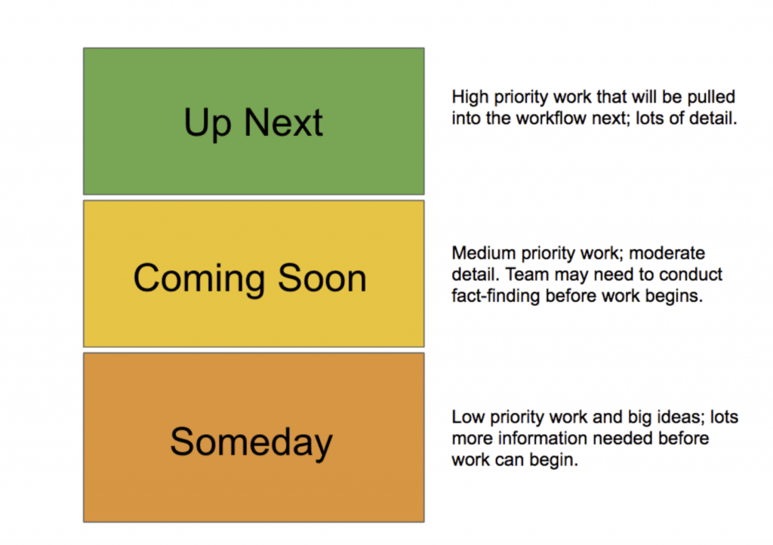
This arrangement allows them to easily prioritize their own daily activities. It clearly demonstrates which projects or tasks are the most important.
These cross-functional teams are persistent, meaning they stay together for the long haul.
Once you have several of these kinds of teams running, your flow of projects changes dramatically.
When something new comes along, you don’t grab a few people to have a kickoff and start working on it. You review your existing teams and decide which of them is best suited to get that work done.
Then you send the work to the team; you don’t pull people to the work.
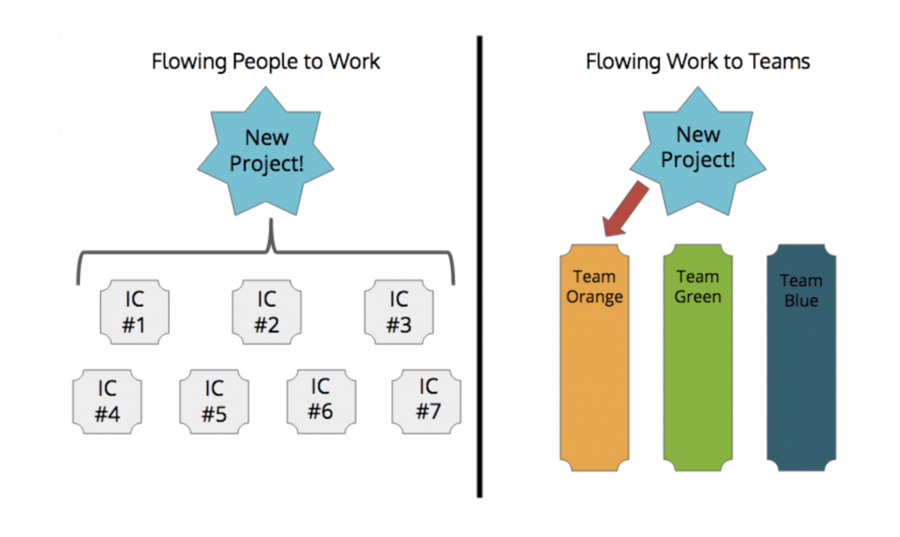
8 Guidelines for Building Stable Agile Marketing Teams
How then do we build these amazing groups of people? When we work with clients we follow these guidelines:
- Shared purpose: Ideally teams form around the shared goal of delivering value to customers. Their purpose should be overarching and clear.
- A few clear KPIs: One of the most important ways a team achieves high performance is through its ability to say “no” to incoming requests. Their core KPI(s) are the filter through which all stakeholder asks must pass; work that won’t deliver on the team’s KPI(s) won’t get accepted.
- Owners of the how: Marketing leadership owns the “what.” They clearly tell teams what objectives are crucial to marketing and organizational success. Then, the team gets to own the “how,” the way they choose to achieve those objectives.
- Crossfunctional: Teams should contain all the necessary skills to execute the work for which they’re responsible. Interdependencies create bottlenecks and delays; we want to avoid them whenever possible.
- Reasonably sized: Whenever possible, keep Agile marketing teams between four and ten people. There are certainly options for teams outside this range, but the research is clear: smaller teams get more done.
- Stable point of contact: One person should act as the buffer between the team and its stakeholders, freeing team members up to focus on executing outstanding work.
- Strategic connection: The above point of contact also connects the team to larger strategy, both at the marketing and organizational level. Together with the shared purpose, this connection provides a clear North star for the team to work towards.
- Psychological safety: Teams need to feel safe speaking their minds, even if that means fundamentally disagreeing with leaders or team members.
I realize this is a big shift for most marketing departments, so let’s go into a bit more detail on these various criteria.
Shared Team Purpose
Teams aren’t just a hodge podge collection of people; they need a meaningful reason to collaborate.
One simple way to do this is by creating teams focused on customers at a particular stage of their buying journey. Perhaps we have a team concentrating on generating new leads and creating an addressable audience. Another team may be focused on converting those people into paying customers. A third is only concerned with upselling, cross selling, and retaining those hard-won customers.
Another option is to design teams who specialize in marketing to a particular persona across their entire buying journey.
You could also have teams supporting different product lines or regions.
The actual makeup of the teams will be highly dependent on what you’re marketing and to whom, but the important thing is to move away from project “teams” and create groups who can stay together for the long term working to serve a particular kind of customer.
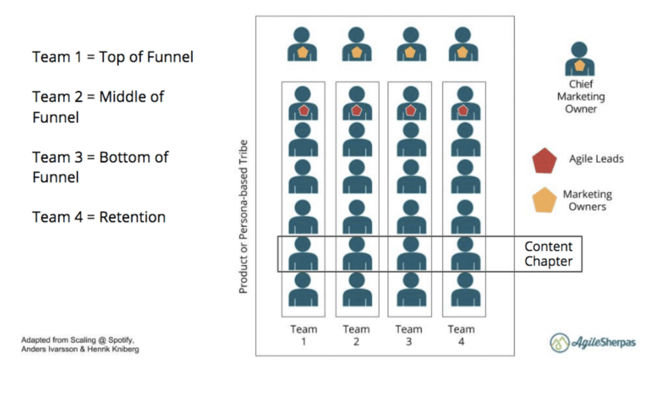
Clear Team KPIs
Combined with clear objectives, giving Agile marketing teams a handful of core KPIs helps them focus their time and energy on value-adding activities instead of busy work.
In other words, stable Agile marketing teams suffer from far less context switching, also known as multitasking.
While particularly prevalent in marketing, context switching is a serious problem in knowledge in general. It happens when our brains have to move from one area of focus to another.
Research has revealed that humans aren’t capable of actually multitasking; we just jump from one thing to another. But our brains need time to process that jump. They can’t instantly refocus.
The time it takes to switch gears is context switching, and it creates huge amounts of waste in our days.
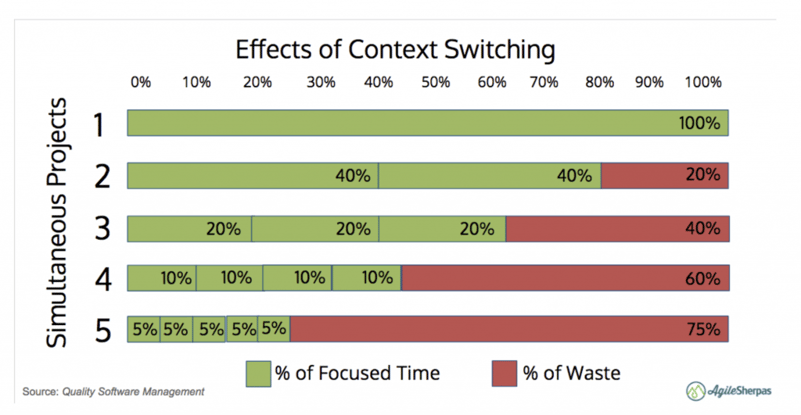
The American Psychological Association reports that even minor mental blocks created by shifting between tasks can consume as much as 40 percent of someone’s productive time.
They’ve also concluded that most of this loss is immune to preparation, meaning that even planned context switching wastes productive time.
Allowing marketers to sit on stable teams that focus on a small number of projects that share a purpose helps alleviate this depressingly common issue. Our goal is to create design teams that are dedicated to serving a particular customer or audience so we can establish focus and flow and eliminate the waste of context switching.
Before proceeding to learn how to own the "How", why don't you take a second to get our Agile Marketing Transformation Checklist?
Owners of the "How"
Agile marketing teams are responsible for the “how.” They take the objectives, apply their experience and expertise, and decide on the activities they’ll undertake to make those objectives reality.
Marketing leadership is responsible for the “what.” They determine the long term strategic objectives that marketing needs to complete. These objectives should ideally be tied to larger organizational objectives as well.
For this partnership to work effectively, leaders need to be comfortable letting go of the how.
If leaders don’t trust the teams to get their stuff done right and on time, they’ll micro-manage the team members. They’ll also slow everything way down by insisting on regular reviews or status updates. Often I hear from teams in highly regulated industries like BFSI or HLS who think this can't apply to them, but we've seen it work in many case studies.
Cross-functional and Reasonably Sized
At their core, Agile marketing teams are made up of dedicated individuals who pool their talents to form a cohesive, persistent team. The exact skill sets a team needs will vary widely depending on the kind of work they do. But, ideally you want all the skills necessary to execute that team’s work contained within the team (also known as being cross-functional).
In other words, you want to reduce dependencies among different teams.
Anytime one Agile marketing team relies on another, there’s a possibility for bottlenecks to emerge and delays to ensue. Not to say those issues won’t ever crop up when a team has no dependencies, but the fewer opportunities we give them to happen the better.
A slightly contradictory mandate for the team is to keep it small, ideally between four and ten people as mentioned earlier.

This can make creating a cross-functional team challenging if you’re working with highly specialized individuals.
But the small team size is necessary, because decades of research on group performance has proven that small groups simply work better together. Once the size gets into double digits sub-teams begin to form within the team, but they do so at an informal level.
These mini-teams can lead to clique-ish behavior that undermines the team’s ability to perform, and eventually erodes all their gains.
Stable Point of Contact with Strategic View
The stable Agile marketing team’s main job is to deliver value to a particular customer, as quantified by their core KPI(s).
To do this, they need the vast majority of their productive time available to actually, well, work.
That means we need to keep them out of meetings whenever possible, because meetings are typically not a value-adding activity. We can’t just eliminate meetings, however, so we concentrate that particular requirement of modern knowledge work into a single person within the team, which we’ll refer to for simplicity’s sake as the Team Lead.
The Team Lead can have almost any traditional marketing title. But, they typically come from the senior managerial level or above.
They need at least a moderate level of seniority to effectively navigate organizational politics, and in some corporate cultures to even be allowed in a room with senior leadership.
Good Agile marketing teams rely heavily on their Team Lead. So, let’s see exactly what this person is responsible for:
- Stable point of contact: Whenever someone outside the Agile team needs something from one of its members, they approach the Team Lead, who then incorporates the request with the team’s existing priorities and current commitments. This eliminates hallway conversations or surreptitious requests that can derail the team’s planned, strategic efforts.
- Managing temporary SMEs and shared resources: In marketing groups these tend to be subject matter experts (SMEs). They have a skillset that’s crucial to a stable Agile marketing team’s success but not necessary all the time. The Team Lead is responsible for making sure the right SMEs are available at the right time to support various teams
- Supporting distributed team members: Another inevitable fact of life for the modern knowledge worker is that some (or maybe even all) of a team won’t work in the same building. When you have a mixed team (some co-located and others distributed), it falls to the Team Lead to ensure the environment supports both kinds of team members.
- Fact-finding and requirements gathering: An Agile marketing team works from a prioritized queue of work, also known as the backlog. When items make their way to the top and it becomes obvious that the team will be tackling them soon. So, the Team Lead goes out and proactively collects the information needed for the team to get started. This may mean taking meetings with stakeholders, gathering requirements, or some combination of those two. The most important thing is that team members focus their efforts on doing work. The Team Lead focuses theirs on enabling that execution.
- Interfacing with agencies: The final piece of marketing complexity that the Team Lead handles are agencies. Their involvement can vary widely depending on the capabilities that a particular team has within it. But, the Team Lead should typically act as the liaison between the marketing team and the agency. I say “typically” because there may be some instances in which an internal SME is better equipped to work with an agency. In those cases a Team Lead may pass this particular duty off to a team member.
Doing the Right Work at the Right Time
Missing from the above list is the Team Lead’s most important responsibility: ensuring the team is doing the right work at the right time. It gets its very own section because of the impact, for good or ill, the Team Lead can have in this arena.
The activity that produces the magical right work-right time execution is prioritizing the team’s backlog, or to-do list. Prioritization conveys which pieces of upcoming work are most important (they’re at the top) and which aren’t (they’re at the bottom).
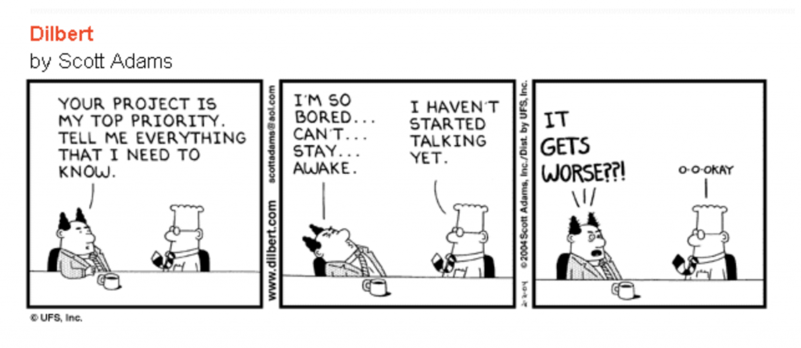
The items at the top of the team backlog are crucial to achieving its core goals. They also align with the direction that marketing as a unit is trying to move.
Less important and/or less time-sensitive work falls to the bottom of the queue. This frees the team up from worrying about when it might become relevant.
As they’re confirming what work is important and placing that work at the top of the backlog, Team Leads also need to make sure the team has all the information necessary to tackle the most important work.
Oftentimes this means having meetings with stakeholders, collecting requirements, reviewing past projects for performance data that might impact the plans, coordinating inter-team dependencies, and more.
As you can imagine, these activities easily fill a full work week.
This workload means your Team Lead should not also be asked to do work within the team.
Because of this distinction you may find that existing project managers do well as Team Leads. Assigning them this role can work, depending on the maturity and performance level of the team they’re working with.
Project managers typically have the organized approach and the internal connections needed to collect requirements and liaise with stakeholders. However, they may lack the strategic perspective necessary to prioritize the backlog, as well as the people wrangling skills required to effectively oversee a fledgling self-organizing Agile team.
While their project oversight and requirements gathering skills may be slightly rusty, marketing director types tend to perform best in this role. If you have to choose between project management skills or strategic capabilities in your Team Lead, favor the latter.
Psychological Safety
Amy Edmondson, creator of this particular concept, defines psychological safety as follows:
Psychological safety is a “shared belief, held by members of a team, that the group is a safe place for taking risks.” It is “a sense of confidence that the team will not embarrass, reject, or punish someone for speaking up...It describes a team climate characterized by interpersonal trust and mutual respect in which people are comfortable being themselves.”
Part of the job of Team Leads and marketing leadership overall is to make sure that team members enjoy psychological safety, and that it permeates across the marketing organization. When either of those are not the case, high performance won’t be possible. Innovation becomes unlikely, and even the basic efficiencies of agility are at risk.
It’s also been revealed through studies of thousands of teams at Google that the presence of psychological safety is the primary indicator of team success.
Psychological safety trumps experience, leadership, expertise, and more. So creating it isn’t a nice to have, it’s an imperative for stable Agile marketing teams to succeed.
Stable Agile Marketing Teams FTW
Stable Agile marketing teams form the foundation of even the most complex implementation. So, take time to build them the right way.
Take it from someone who’s seen the outcomes of both options. It’s far better to delay an Agile transformation than to start with haphazard teams.
(Feeling overwhelmed by building stable Agile marketing teams? Give me a shout and I can lend a hand.)
For more on scaling agility across the marketing organization, check out this overview.
Curious to learn how ready you are for an Agile transformation? Find out with our special checklist:
Topics discussed

Andrea Fryrear is a co-founder of AgileSherpas and oversees training, coaching, and consulting efforts for enterprise Agile marketing transformations.
Improve your Marketing Ops every week
Subscribe to our blog to get insights sent directly to your inbox.




